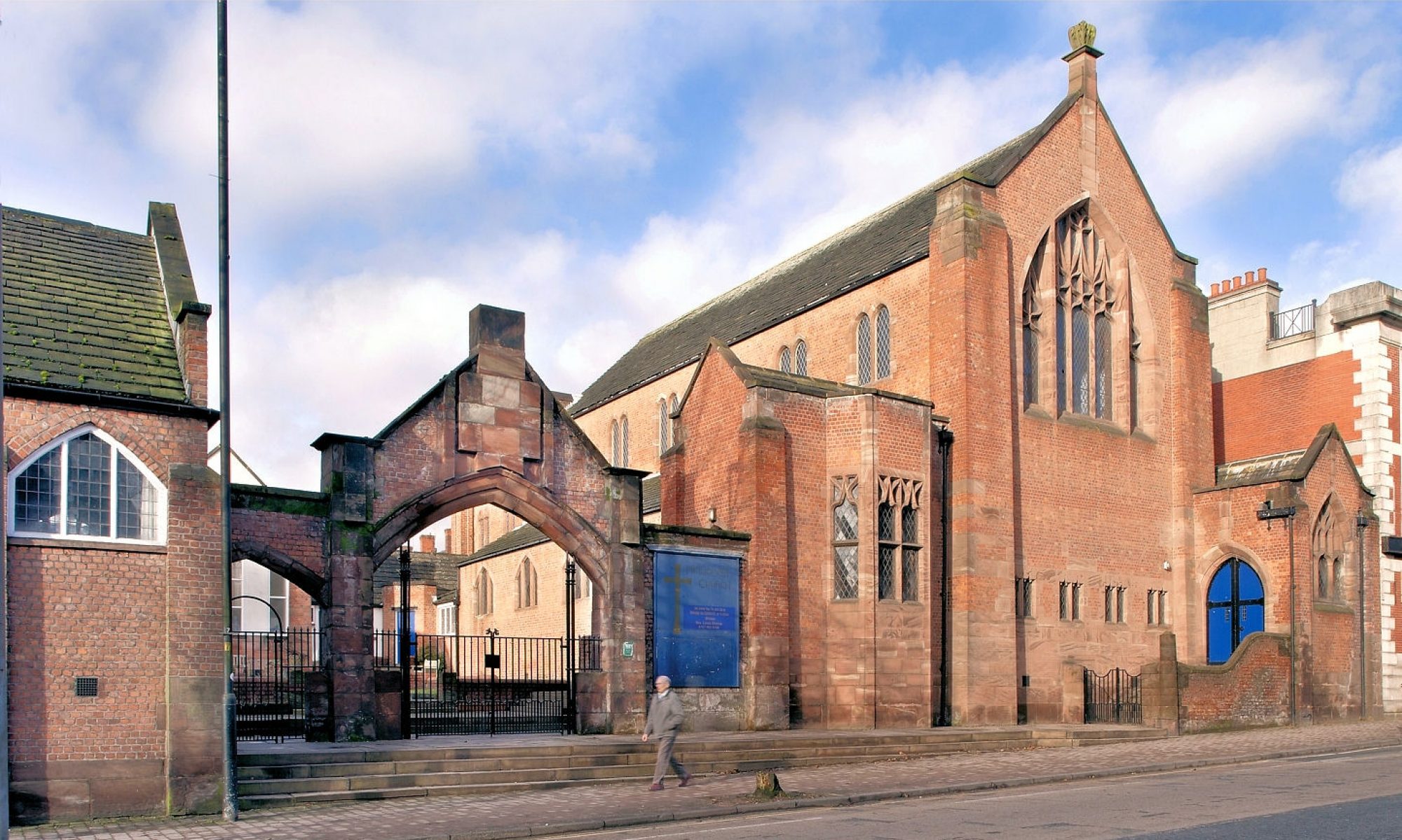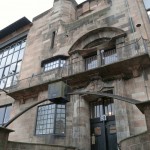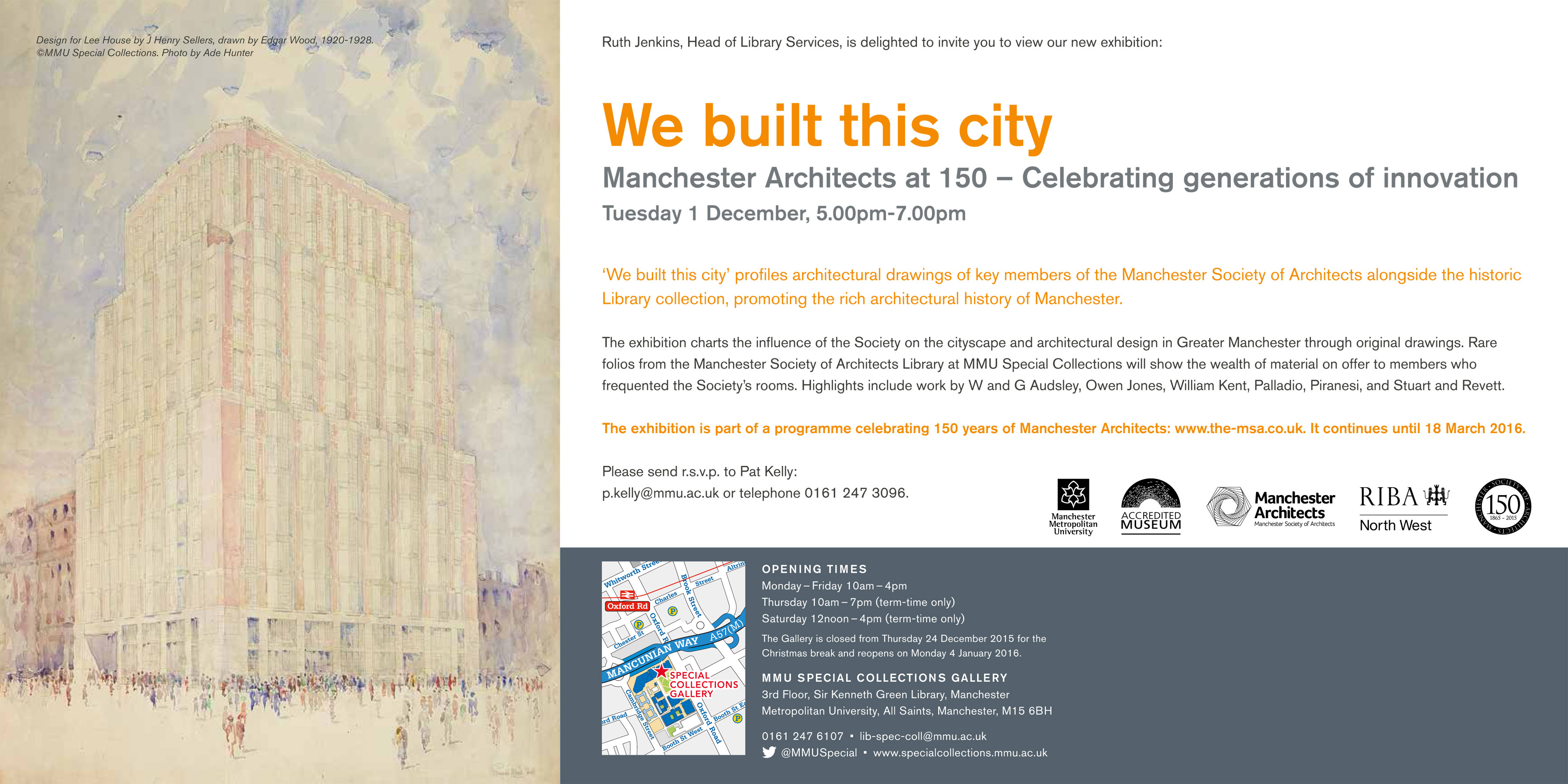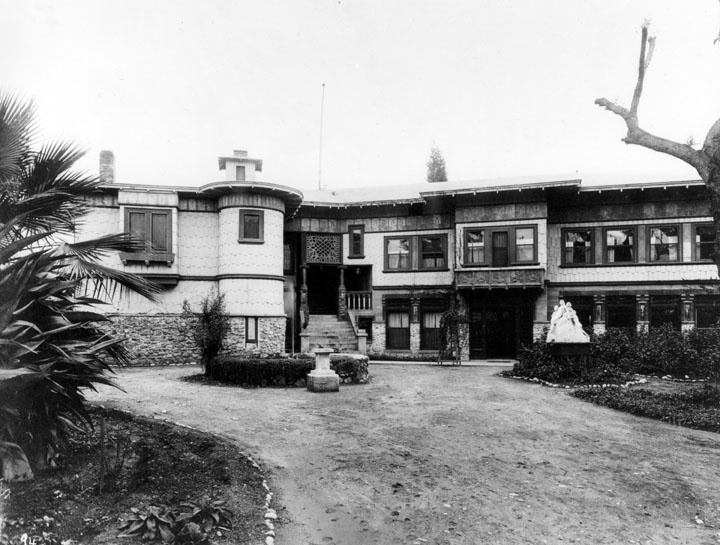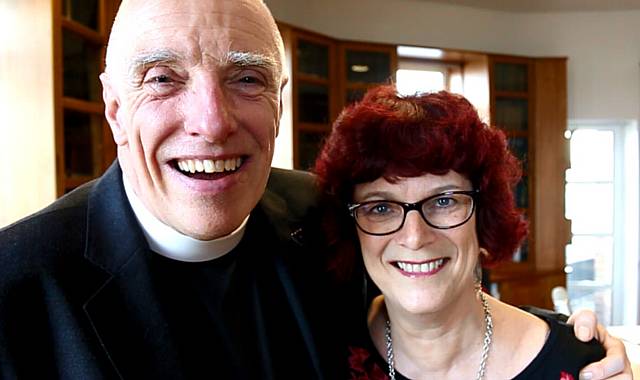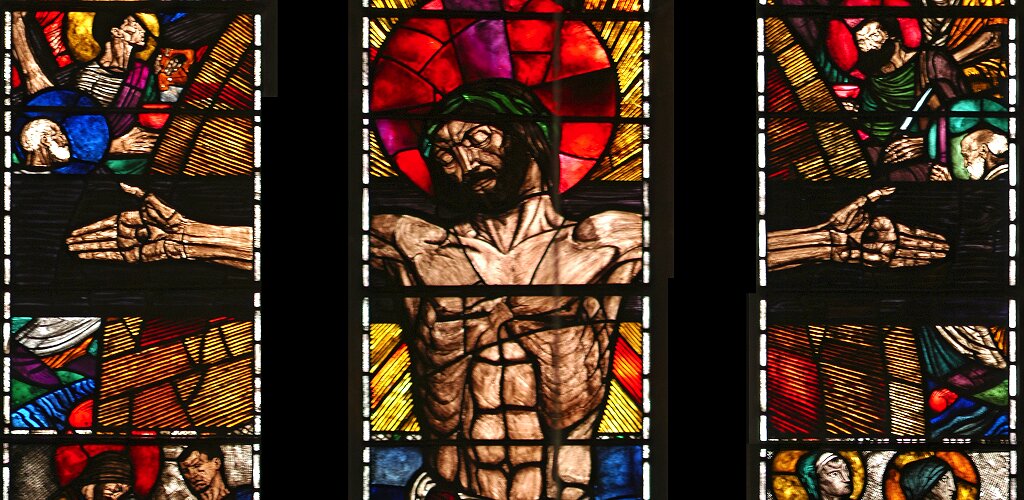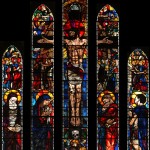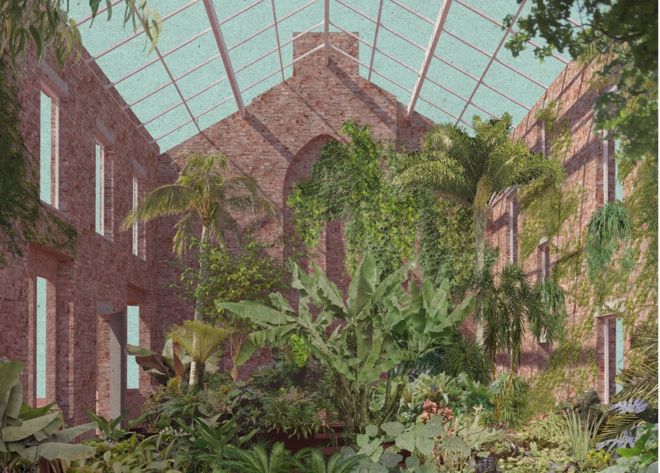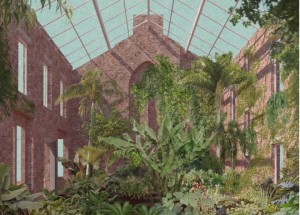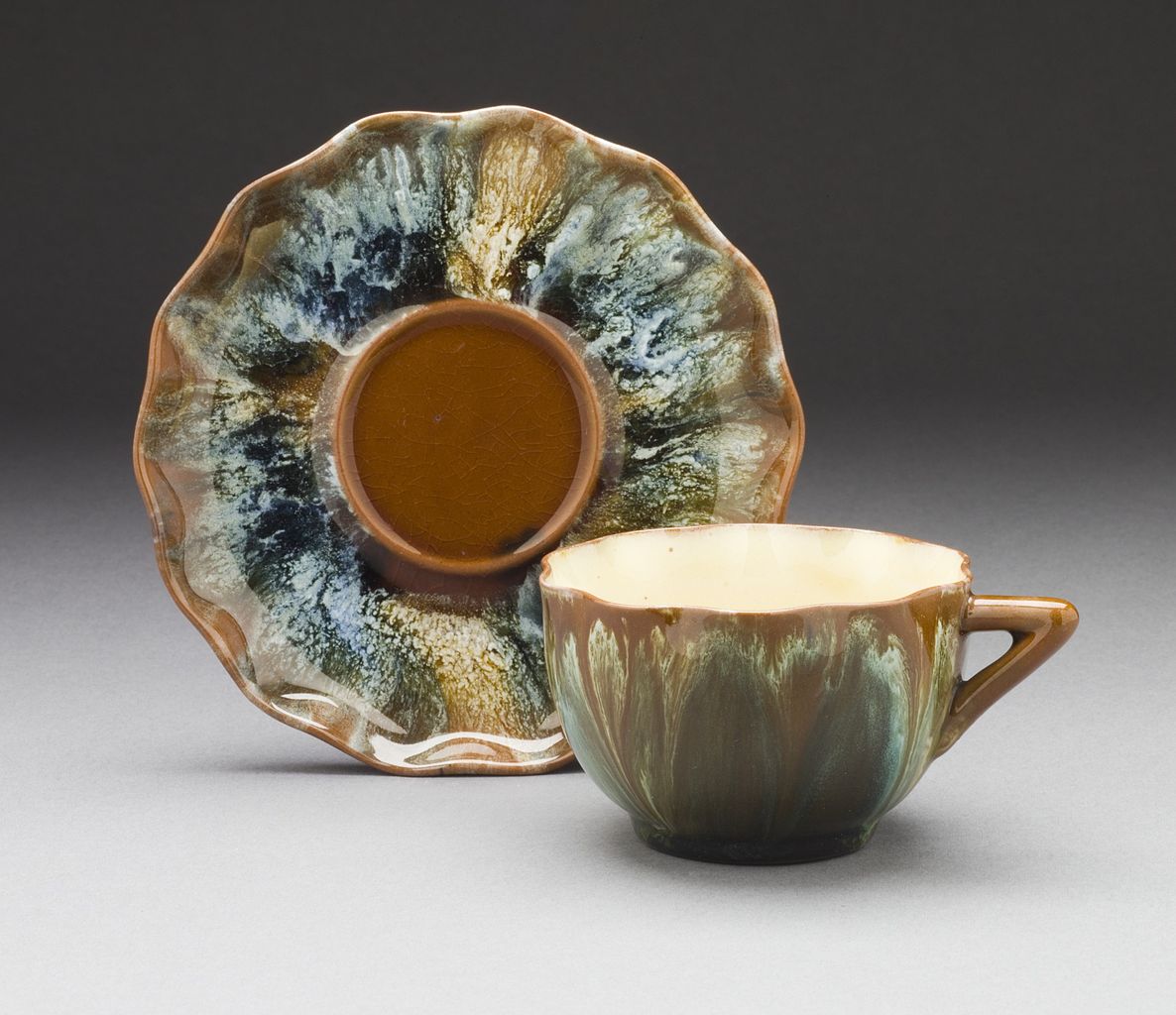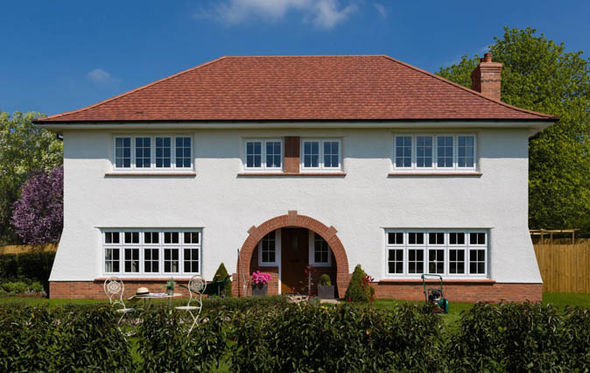3D images of fire-damaged Glasgow School of Art Mackintosh building
Manchester Evening News article on Redcroft
Home of renowned Middleton architect Edgar Wood is given a facelift
Saving a Century – Victorian Society Exhibition
Saving a Century – Victorian Society Exhibition
The Victorian Society’s photographic exhibition Saving a Century, curated by noted architectural historian Gavin Stamp, is on show free of charge at The John Rylands Library, 150 Deansgate, Manchester, M3 3EH, from 8 January – 24 March, daily during Library hours.
Using archive photographs and material from over fifty years of the Victorian Society’s fight to save historic buildings, the exhibition charts the successes and defeats of the organisation that has done so much to change public attitudes towards the nineteenth century’s best architecture. After more than 60 venues around Britain this is the final showing of the exhibition, which includes local images from Manchester, Oldham, Ashton-under-Lyne, Middleton, Preston and Nelson.
THE FOUNDATION OF THE VICTORIAN SOCIETY – Photographs and material from the opening meetings of the Society. Early members included architect Hugh Casson, architectural historian Christopher Hussey, Sir Nikolaus Pevsner and Sir John Betjeman.
THE EUSTON MURDER AND OTHER CASES – Photographs and text documenting the bitter battle for the Euston Arch, as well some of the Victorian Society’s other early defeats. There were early victories too, among them the Oxford University Museum, proposed for demolition in 1961 to make way for new science buildings. The Victorian Society also succeeded in getting the Broad Street Building of Balliol College listed, after it was threatened with a re-build in 1963.
VICTORY IN WHITEHALL – Photographs charting the heroic, ten-year campaign against plans to demolish much of the historic square mile, including nearly every building south of Downing Street and Richmond Terrace. Sir George Gilbert Scott’s Foreign Office, Richard Norman Shaw’s New Scotland Yard and Middlesex Guildhall in Parliament Square were among the buildings proposed for demolition.
PLACES OF WORSHIP – A photographic survey of some of the historic churches, chapels and synagogues with which the Victorian Society has been involved. As churches are exempt from the secular planning system, it can be particularly difficult to guard them against insensitive change. With falling attendance figures and a growing number of redundant places of worship, the future of our best churches is one of the biggest challenges facing heritage campaigners today.
RAILWAY BUILDINGS – Photographs of some of the key buildings the Victorian Society fought for, as the closure of many branch and other railway lines resulted in the redundancy of numerous stations, bridges and viaducts. That many pioneering and magnificent railway structures, such as St Pancras Station, survive today, often still in use, is very much owing to the efforts of the Society.
IRON, GLASS & STONE – Photographs of some of the most innovative nineteenth century buildings, among them Clevedon Pier, Islington’s Royal Agricultural Hall and Bradford’s Kirkgate Market, for which the Victorian Society has fought.
THE FUNCTIONAL TRADITION – Photographs of some of the most impressive industrial buildings for which the Society has fought. With the decline of the traditional industries of the North of England after the Second World War, many mills and warehouses became redundant while many Northern towns and cities became ashamed of their Victorian industrial legacy and anxious to replace it with something new. The Victorian Society, along with bodies such as SAVE Britain’s Heritage, argued that nineteenth century industrial buildings were evocative and substantial structures which were not only of historical importance but capable of gainful re-use.
THE PURPLE OF COMMERCE – Photographs of some of the most significant Victorian commercial buildings to have come under threat in the last fifty years. Built partly as self-advertisements and partly to inspire confidence, these ambitious and substantial banks, offices and warehouses too often fall victim to redevelopment schemes.
COUNTRY HOUSES – Photographs of some of the grandest country houses to have been the subject of Victorian Society campaigns, among them Shadwell Park, Tyntesfield and Highcliffe Castle. Rendered redundant by social and cultural changes, some of the most famous large houses were demolished between the wars while many more disappeared in the 1950s.
DOMESTIC ARCHITECTURE – A collection of photographs of some of the Victorian villas and terraced houses for which the Victorian Society has fought. Often extravagant and fanciful buildings, these buildings are regularly demolished to allow higher density developments in their grounds or make way for flats.
PUBLIC INSTITUTIONS – A photographic survey of some of the best municipal buildings that have been saved or lost. Physical embodiments of the Victorians’ strong sense of civic pride and duty, many of these splendid town halls, libraries, swimming pools, museums, art galleries and post offices still add much to the rich character of British towns and cities today.
BEACONS OF THE FUTURE – A survey of some of the Society’s most recent campaigns, focusing on the battle for Victorian schools and swimming pools. Among the battles highlighted are the protest and funeral forBonner School, the Public Inquiry for Easington Colliery School and the local campaign for the Moseley Road Baths in Birmingham.
THE VICTORIANS VICTORIOUS – Photographs of some of the most notable Victorian buildings used and valued today.
Family Archive on Edgar Wood’s Arkholme Saved
 A collection of documents and photographs about Edgar Wood’s Arkholme, 1 Towncroft Avenue formerly belonging to the Taylor family is to go to the Edgar Wood Middleton archive, thanks to historian Geoff Wellens.
A collection of documents and photographs about Edgar Wood’s Arkholme, 1 Towncroft Avenue formerly belonging to the Taylor family is to go to the Edgar Wood Middleton archive, thanks to historian Geoff Wellens.
The collection is a crucial source of information on what is Edgar Wood’s very first flat roofed design. It was erected in 1901 a year or two before he met J. Henry Sellers, with whom he was to pioneer art deco design.
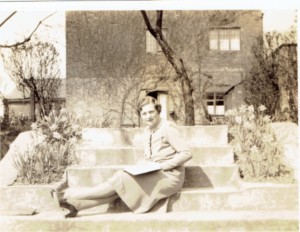 The material includes photographs of the house as it was in the days of its first occupant, Edgar Wood’s friend Charles Jackson, brother of painter Fredrick Jackson, before it was (sensitively) altered in the 1950s by the Taylor family. It also has images of Towncroft Avenue being widened, letters and invoices from tradespeople who worked on the house.
The material includes photographs of the house as it was in the days of its first occupant, Edgar Wood’s friend Charles Jackson, brother of painter Fredrick Jackson, before it was (sensitively) altered in the 1950s by the Taylor family. It also has images of Towncroft Avenue being widened, letters and invoices from tradespeople who worked on the house.
The Edgar Wood archive is managed by the Society curator Nick Baker.
Joe Richards: Inspired by William Morris
Joe Richards: holding pattern
Inspired by the work of William Morris, designer Joe Richards is bringing the handmade ideals of the Arts and Crafts movement to our wardrobes. Tamsin Blanchard reveals how in this Article
New UK online Art Gallery is up and running
The nation’s database of art in public collections, Art Uk http://artuk.org/ is now online. It’s an amazing project that extends the BBC’s Your Paintings online galleries.and shows online all the paintings in the nations art galleries.
As well as Arts & Crafts workers, the Midddleton area produced four outstanding painters in the years around 1900. Click the links to see their work…
Frederick William Jackson 1859–1918
William Edward Stott 1859–1918
‘We built this city’ – Manchester Architects at 150
This exhibition about the last 150 years of the Manchester Architects Society has been running since December 2015 but closes on 18th March 2016 – so don’t miss it!
OPENING TIMES – FREE ADMISSION
Monday – Friday 10am – 4pm
Thursday 10am – 7pm (term-time only)
Saturday 12noon – 4pm (term-time only)
Location – Special Collections Exhibition Space, 3rd Floor, Sir Kenneth Green Library, MMU, All Saints, Manchester – M15 6BH (contact details below)
‘We built this city’ profiles architectural drawings of key members of the Manchester Society of Architects alongside the historic Library collection, promoting the rich architectural history of Manchester.
The exhibition charts the influence of the Society on the cityscape and architectural design in Greater Manchester through original drawings. It reveals the personalities behind the Society, connecting the city with a distinguished lineage of architects, such as founders Alfred Waterhouse and Thomas Worthington. Drawings by Edgar Wood and James Henry Sellers will profile their key works in the city. The exhibition explores the establishment of the Society’s education programme, innovations in building technology, and influence on Town Planning and Conservation.
Rare folios from the Manchester Society of Architects Library at MMU Special Collections show the wealth of material on offer to members who frequented the Society’s rooms. The Library was created as a teaching tool for students and practitioners to further their understanding of architecture. Highlights include: W and G Audsley’s Polychromatic decoration, 1881; Owen Jones’ Plans, sections and details of the Alhambra, 1842; William Kent’s The design of Inigo Jones, 1770; Palladio’s The four books of Architecture, 1738; Piranesi’s Opera, 1762; and Stuart and Revett’s Antiquities of Athens, 1762-1816.
The exhibition is part of a programme celebrating 150 years of Manchester Architects:
www.the-msa.co.uk
MMU SPECIAL COLLECTIONS GALLERY
3rd Floor, Sir Kenneth Green Library, Manchester
Metropolitan University, All Saints, Manchester, M15 6BH
0161 247 6107 • lib-spec-coll@mmu.ac.uk
@MMUSpecial • www.specialcollections.mmu.ac.uk
When entering the library please report to the main library desk for access through the security gates. Turn left and take the lift to the 3rd floor. The Special Collections is on the right when exiting the lift.
Edgar Wood Society to contribute to South Hale Conservation Area Management Plan – Can You Help?

South Hale Conservation Area in the Metropolitan Borough of Trafford includes a series of eight Edgar Wood designed detached houses, all closely located to one another. Each house is a highly individual Arts & Crafts design which, taken together, makes for one of the finest groups of Arts & Crafts houses by a single architect in the country. Each house design evolves from its predecessor and the group is remarkable in illustrating how Edgar Wood developed modern art deco architecture from the Arts and Crafts.The earliest house is Halecroft, built as an Arts & Crafts ‘tour de force’ in 1890 early in Edgar Wood’s career. Then come six houses built between 1901 and 1907, at roughly one a year, which incrementally move toward the art deco style. Finally, the amazing Royd House (pictured above) was designed in 1914, which Edgar Wood built for himself when he left Middleton at the end of the First World War.
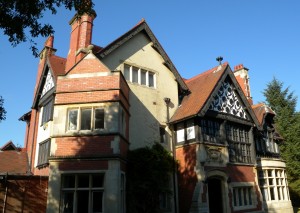
All the houses are listed Grade II, except for Halecroft which is Grade II* and Royd House which is Grade I.
The Edgar Wood Society is writing an appreciation of the houses for Trafford Council town planners which, hopefully, will inform the management plan for the conservation area. If you have any information, photos or contacts regarding these buildings, please let us know, we would be very grateful – just Leave a Reply below and we’ll get back to you. Thanks, David.
Furniture pioneer Gustav Stickley
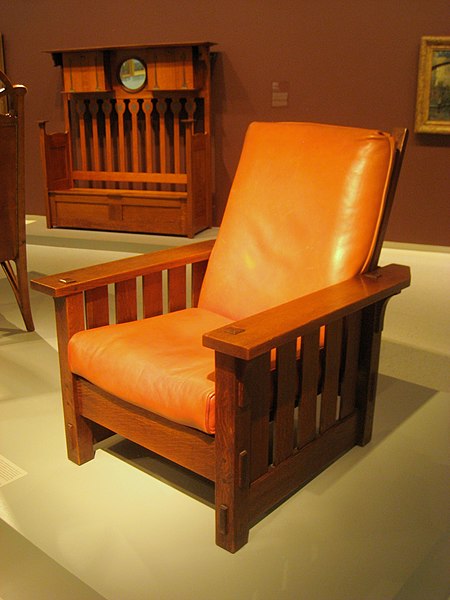
Gustav Stickley is considered by many to be the father of the Arts and Crafts movement in the United States. Here is a recent article from the American press about his furniture company.
Mary Sloane: A Portrait of the Artist
Here is an upcoming Spring/Summer exhibition in Leicester that looks interesting… CLICK HERE for details.
The Nature of William S. Rice: Arts and Crafts Painter and Printmaker
The Nature of William S. Rice: Arts and Crafts Painter and Printmaker – A Californian Arts and Crafts master is celebrated in a new exhibition at the Pasadena Museum. REPORT HERE
Arts & Crafts stained glass makers workshop…
Mission and Heritage – Methodist Christmas Message
 Mission and Heritage – Methodist Christmas Message – Revd Steven Wild, President of the Methodist Church, gives his Christmas message – Click Here for Rochdale Online article
Mission and Heritage – Methodist Christmas Message – Revd Steven Wild, President of the Methodist Church, gives his Christmas message – Click Here for Rochdale Online article
Wilhelmina Geddes rediscovered in new book
 Wilhelmina Geddes rediscovered in new book – Wilhelmina Geddes: Life and Work, by Nicola Gordon Bowe… Jasmine Allen admires the monumental scale and meticulous detail of a stained glass artist’s work.
Wilhelmina Geddes rediscovered in new book – Wilhelmina Geddes: Life and Work, by Nicola Gordon Bowe… Jasmine Allen admires the monumental scale and meticulous detail of a stained glass artist’s work.
Turner Prize rediscover the art of controversy
art deco cinemas of Scotland
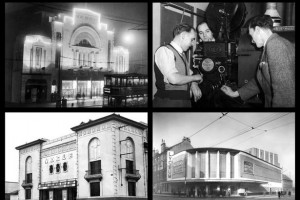 Here is a nice collection of deco cinemas in Scotland which shows the variety of design that is called art deco.
Here is a nice collection of deco cinemas in Scotland which shows the variety of design that is called art deco.
Christopher Dresser
Dr. Christopher Dresser (1834-1904) changed the course of “modernist” design more than any other individual in Britain at the end of the 19th century… CLICK HERE FOR MORE
Image: Japanesque Style Cup and Saucer, circa 1879-1882. Wikimedia Commons – Los Angeles County Museum of Art http://collections.lacma.org/node/184492
‘The Arts and Crafts House: Then and Now’
‘The Arts and Crafts House: Then and Now’ exhibition at the Laing Art Gallery explores, within an intimate space, the legacy of artists of the 19th century Arts and Crafts movement.
CLICK HERE for article.
